*NURSING > QUESTIONS & ANSWERS > FNDH 620 - Final Exam 2022 (COMPLETE SOLUTIONS)., Rated A (All)
FNDH 620 - Final Exam 2022 (COMPLETE SOLUTIONS)., Rated A
Document Content and Description Below
FNDH 620 - Final Exam 2022 (COMPLETE SOLUTIONS) True or False Vitamins: - cannot be made in the body - noncaloric - required in small amounts (mg and mcg) - ✔✔TRUE Vitamins: - cannot be ma... de in the body - noncaloric - required in small amounts (mg and mcg) What 3 forms can vitamin A take? - ✔✔- retinol (alcohol) - retinal (aldehyde) - retinoic acid (acid form from retinal) What form of vitamin A is normally found in blood and tissues? - ✔✔Retinyl Palmitate What form of vitamin A is found in plants? - ✔✔Previtamin A - carotenoid structure that includes the carotenes and xanthophylls - found in plants - needs to be converted to active vitamin A What is the most potent form of vitamin A? - ✔✔Beta caroteneWhere can retinyl esters be found? - ✔✔Animal Products *only* Where can vitamin A be found? - ✔✔Fortified milk and milk products Where can previtamin A carotenoids be found? - ✔✔Plant sources - orange and dark green vegetables Vitamin A containing micelles form and traverse the enterocyte plasma membrane by what type of diffusion? - ✔✔Passive Diffusion What two things are needed in the digestion of vitamin A? - ✔✔Bile and Fat Beta-carotene and other carotenoids can be converted to retinol by what means? - ✔✔Beta-carotene and other carotenoids can be converted to retinol by cleavage of the central double bond When beta-carotene is cleaved, how many molecules of retinal does it make? - ✔✔1 beta-carotene = 2 retinal Retinyl, retinyl esters, and carotenoids are packaged into what and transported where? - ✔✔Retinyl, retinyl esters, and carotenoids are packaged in *chylomicrons* and transported in the *lymphatic system*. Vitamin A and carotenoids are metabolized where and as what? - ✔✔Vitamin A and carotenoids are metabolized in the liver as chylomicron remnants. Retinoic acid is absorbed and transported to which organ bound to what protein? - ✔✔Retinoic acid is absorbed and transported to the liver bound to albumin. The liver stores 90% of which vitamin? - ✔✔vitamin AWhat are the functions of vitamin A & Carotenoids? - ✔✔- Improves vision - Cell differentiation & cell proliferative activity - Fights cancer - Development of embryo tissue - Synthesis of glycoproteins - Reproductive processes - Antioxidant capacity - Bone development and maintenance - Provides immunity How is vitamin A essential to our vision? - ✔✔- retinol is transformed into 11-cis retinal through a series of reactions - 11-cis retinal combines with the protein opsin forming rhodopsin - Rhodopsin + light changes the conformation of the protein which begins a cascade of events leading to the generation of an action potential - This action potential sends neural impulses to the optic center of the brain translating it into images What are the 2 nuclear receptors that work with vitamin A on a molecular level? - ✔✔RAR & RXR Vitamin A is beneficial for all cancers but... - ✔✔lung cancer Vitamin A is involved in sperm development and differentiation, without it, what happens? - ✔✔Without RARγ, males are sterile If a female is low or deficient in vitamin A, what could happen? - ✔✔deficiency: inability of implantation of the egg low: may allow implantation but may end in a miscarriage; various birth defects Vitamin A is excreted in _____ & _____. - ✔✔Vitamin A is excreted in the bile (70%) and urine (30%).RDA of vitamin A for men - ✔✔900 mcg/day RDA of vitamin A for women - ✔✔700 mcg/day 12 mcg beta-carotene = ??? mcg of retinol - ✔✔12 mcg beta-carotene = 1 mcg of retinol Vitamin A deficiency is the leading cause of ___________ in children worldwide. - ✔✔Vitamin A deficiency is the leading cause of *non-accidental blindness* in children worldwide. Diseases caused by vitamin A deficiency - ✔✔- night blindness - xerophthalmia - bitot spots Symptoms of vitamin A toxicity - ✔✔- decreased appetite - dry, itchy, flaky skin - headache - hair loss - bone/muscle pain - ataxia - nausea/vomiting - dry mouth - eye irritations - conjunctivitis - birth defects - miscarriage - learning difficulitiesThis unique vitamin is synthesized in the body with adequate sun exposure as well as it's ability to function as a hormone. - ✔✔Vitamin D What are the two forms of vitamin D? - ✔✔D2 - ergocalciferol D3 - cholecalciferol UV light converts __________ into cholecalciferol (D2). - ✔✔UV light converts *7-dehydrocholesterol* into cholecalciferol (D2). Aside from humans being able to produce their own amounts of vitamin D, it can also be found in: - ✔✔- animal foods (eggs, liver, fatty fish, & butter) - fortified milk and dairy products - fortified margarine Vitamin D enters mucosal enterocytes by __________ diffusion. - ✔✔Vitamin D enters mucosal enterocytes by *passive* diffusion. Vitamin D becomes part of __________ and then enters the __________ circulation. - ✔✔Vitamin D becomes part of *chylomicrons* and then enters the *lymph* circulation. 40% of vitamin D is transported in chylomicrons. The remaining 60% is transported by what protein? - ✔✔D-binding Protein (DBP) - this is also the same protein that picks up vitamin D created in the skin The efficiency of binding to vitamin D is increased after two ____________. - ✔✔The efficiency of binding to vitamin D is increased after two *hydroxylations*. Both the _____ and the _____ add a hydroxyl group to the vitamin D structure. - ✔✔Both the *liver* and the *kidneys* add a hydroxyl group to the vitamin D structure.When vitamin D levels are low, what becomes more efficient? - ✔✔25-hydroxylase When light hits the skin, what is the pathway for it to become vitamin D? - ✔✔Sun - skin -- 7-dehydrocholesterol --- liver: 1st hydroxylation ---- kidney: 2nd hydroxylation ----- 1, 25(OH)2VitD3 ------ Metabolically active form What is the most potent vitamin D metabolite? - ✔✔1,25-dihydroxycholecalciferol Functions of vitamin D - ✔✔- regulation of gene expression - affects calcium & phosphate homeostasis - differentiation of stem cells in bone tissue - differentiation of hair follicles & skin cells AI recommendation for vitamin D in infants to 50yrs - ✔✔5 mcg/day AI recommendation for vitamin D in > 50yrs - ✔✔15 mcg/day AI recommendation for vitamin D in > 70yrs - ✔✔20 mcg/day UL recommendation for vitamin D in > 9yr - ✔✔50-100 mcg What diseases are caused by vitamin D deficiency? - ✔✔- Rickets - OsteomalaciaFailure of growing bones to mineralize properly. This results in bowing of long, weight-bearing bones. - ✔✔Rickets Vitamin D deficiency in adults. This results from decreased calcium and phosphate absorption. aka, soft bones - ✔✔Osteomalacia At risk groups for vitamin D deficiency - ✔✔- insufficient sunlight exposure - aging reduces D synthesis in skin - fat malabsorption - anticonvulsant drug therapy - breast fed infants - renal disease Tocopherols are __________ while tocotrienols are __________. - ✔✔Tocopherols are *saturated* while tocotrienols are *unsaturated*. Food sources of vitamin E - ✔✔- plant oils - oil derived products - wheat germ & oil & nuts - some fruits & vegetables (peaches & asparagus) - meat & fish Tocopherols are ______ prevalent than tocotrienols. - ✔✔Tocopherols are *more* prevalent than tocotrienols. What form of vitamin E is most potent? - ✔✔alpha-tocopherol What is the DRI for vitamin E for adults? - ✔✔15 mg/day (alpha-tocopherol) What is the absorption efficiency of vit E? - ✔✔20 - 50%Some vitamin E enters the __________ via lipoprotein lipase. - ✔✔Some vitamin E enters the *body's tissues* via lipoprotein lipase. Some can translocate into circulating __________. - ✔✔Some can translocate into circulating *HDLs*. Some vitamin E is released in liver cells where it binds to _____________________. - ✔✔Some vitamin E is released in liver cells where it binds to *hepatic tocopherol transfer protein (HTTP)*. HTTP incorporates vitamin E into __________. - ✔✔HTTP incorporates vitamin E into *VLDL*. What are the primary storage sites for vitamin E? - ✔✔- liver - adipose tissue - skeletal muscle - lipoproteins What are the secondary storage sites for vitamin E? - ✔✔- adrenals - heart - lungs - brain How is vitamin E excreted from the body? - ✔✔- bile & fecal losses (major route) - sloughing of enterocytes - skin secretions, dermal exfoliation - urinary losses Functions of vitamin E - ✔✔- antioxidant for cell membrane integrity - may exert influence on gene expression - may decrease heart disease through decreased development of atherosclerotic plaque- may decrease dementia (900mg alpha-tocopherol) How does vitamin E act as an antioxidant? - ✔✔Prevents oxidation of unsaturated FA components of membrane phospholipids. RDA for vitamin E is __________ for adult men and women, using __________ as the reference isomer. - ✔✔RDA for vitamin E is *15 mg/day* for adult men and women, using *alpha-tocopherol* as the reference isomer. - other isomers are not as bioavailable and are not included as part of daily dietary value. Symptoms of vitamin E deficiency: - ✔✔- associated with cellular membrane degeneration - destruction of RBC membranes (hemolytic anemia) - degeneration of neuronal & muscular membranes - retinal degeration - Rare and slow to develop, taking up to a year for signs to show. (except if pt has maldigestion of lipids - cystic fibrosis, celiac disease, hepatic & biliary insufficiency, imparied lipoprotein production) Symptoms of vitamin E toxicity: - ✔✔Relatively nontoxic, but symptoms may include: - fatigue - muscle wasting - GI distress - megadosing (anything over a gram/day) may decrease the absorption of other fat soluble vitamins What is the principle transport vehicle for vitamin E in the blood? - the blood plasma - lipoproteins- cytochrome P450 system - alpha tocopherol - ✔✔What is the principle transport vehicle for vitamin E in the blood? - lipoproteins Decreased appetite, headache, bone & muscle pain, ataxia, eye irritation, & resorption of a fetus, abortion, and development of birth defects are most likely the result of toxicity of which of the following vitamins? - vitamin A - vitamin D - vitamin E - vitamin K - ✔✔Decreased appetite, headache, bone & muscle pain, ataxia, eye irritation, & resorption of a fetus, abortion, and development of birth defects are most likely the result of toxicity of which of the following vitamins? - vitamin A Vitamin K comes in 3 forms: __________ is from plants, __________ is produced by bacteria in the gut, and __________ is synthetic. - ✔✔Vitamin K comes in 2 forms: *phylloquinone* is from plants, *menaquinones* is produced by bacteria in the gut, and *menadione* is synthetic. Sources of vitamin K - ✔✔Excellent sources - plant foods (spinach, broccoli, brussels sprouts, cabbage, lettuce, kale Some vit K is found in: - cereals, meats, nuts, legumes, dairy, & fruit Phylloquinone is absorbed by __________ transport in the duodenum & jejunum. - ✔✔Phylloquinone is absorbed by *active* transport in the duodenum and jejunum. Menaquinone & menadione are absorbed by __________ diffusion in the distal ileum and colon. - ✔✔Menaquinone & menadione are absorbed by *passive* diffusion in the distal ileum and colon.Absorption is __________ influenced by bile acids such as pancreatic & biliary secretions. - ✔✔Absorption is *positively* influenced by bile acids such as pancreatic & biliary secretions. Just like vitamins A, E, & D, vitamin K is incorporated into __________ and then enters __________ circulation. - ✔✔Just like vitamins A, E, & D, vitamin K is incorporated into *chylomicrons* and then enters *lymphatic* circulation. After entering the lymphatic circulation, vitamin K eventually reaches the __________ where it is incorporated into __________. - ✔✔After entering the lymphatic circulation, vitamin K eventually reaches the *liver* where it is incorporated into *VLDLs*. Functions of vitamin K - ✔✔- essential for blood clotting - various vit K dependent proteins identified in bone and kidney cells - may play a role in osteoporosis prevention Both __________ and __________ pathways involve clotting factors that are dependent on the vitamin K post-translational modification. Therefore, proper blood coagulation is sensitive to vitamin K status. - ✔✔Both *intrinsic* and *extrinsic* pathways involve clotting factors that are dependent on the vitamin K post-translational modification. Therefore, proper blood coagulation is sensitive to vitamin K status. __________ is produced in osteoblasts in bone and in the dentin of teeth. - ✔✔*Bone GLA Protein (BGP)* is produced in osteoblasts in bone and in the dentin of teeth. __________ is associated with the matrix of bone, dentin, & cartilage. - ✔✔*Matrix GLA Protein (MGP)* is associated with the matrix of bone, dentin, & cartilage. AI for vitamin K in adult women is _____ mcg/day - ✔✔AI for vitamin K in adult women is *90* mcg/day AI for vitamin K in adult men is _____ mcg/day - ✔✔AI for vitamin K in adult men is *120* mcg/day TRUE or FALSEVitamin E should be given to all newborns as a single, intramuscular dose of 0.5 - 1.0 mg. - ✔✔FALSE *Vitamin K* should be given to all newborns as a single, intramuscular dose of 0.5 - 1.0 mg. Who is at risk for vitamin K deficiency? What are the symptoms? - ✔✔Deficiency is uncommon but can happen because it is not stored well in human tissue. - Infants - Those who take certain antibiotics for an extended period of time Vitamin K toxicity - ✔✔Rare in natural form, but the synthetic form (menadione), may pose a risk if taken in megadoses. What are the water soluble vitamins? - ✔✔B vitamins and vitamin C True or False The water-soluble vitamins produce energy & aid in metabolism. - ✔✔False The water-soluble vitamins *do not* produce energy *but* aid in energy metabolism. Scurvy is a disease that was prevalent amongst sailors in the mid-1700s. 90% of sailors were either dying or coming back incapacitated due to it. What missing vitamin was causing this disease? - ✔✔Vitamin C deficiency causes scurvy. Humans __________ produce vitamin C. - ✔✔Humans *cannot* produce vitamin C. Vitamin C is considered an antioxidant because it donates/accepts __________ atoms. - ✔✔Vitamin C is considered an antioxidant because it donates/accepts *hydrogen* atoms.What form of vitamin C is active in humans? - D form - L form - Both D & L form - Neither D nor L form - ✔✔What form of vitamin C is active in humans? - D form - *L form* - Both D & L form - Neither D nor L form Vitamin C is water __________ and heat __________. - ✔✔Vitamin C is water *soluble* and heat *labile*. What can destroy vitamin C? - ✔✔- alkali - oxidation - light - contact with iron & copper What enzyme do animals have that humans do not that allows them to synthesize vitamin C? - ✔✔Lgulonolactone oxidase Sources of vitamin C - ✔✔- fruits - vegetables - fresh, raw are ideal Vitamin C is __________ transported by a sodium-dependent & __________-__________ carrier mechanism. - ✔✔Vitamin C is *actively* transported by a sodium-dependent & *gradient*-*coupled* carrier mechanism.True or False The more vitamin C you consume the more you absorb. For example, if you consume 180mg, you will absorb 25%. But if you consume 5g, you will absorb 80%. - ✔✔False The more vitamin C you consume the *less* you absorb. For example, if you consume 180mg, you will absorb *80%*. But if you consume 5g, you will absorb *only 25%*. Functions of vitamin C - ✔✔- cofactor in several reactions - collagen synthesis - increases absorption of iron - helps form carnitine - production of numerous neurotransmitters - production of serotonin - serves as water-soluble antioxidant - release of adrenal hormones - protection of LDLs from odixation Vitamin C activates what enzyme involved in collagen synthesis? - ✔✔Vitamin C activates *hydroxylase* enzymes involed in collagen synthesis. What is the most abundant protein? - ✔✔Collagen - tendons, bones, cartilage, skin _____ & _____ hydrozylases both require iron as a cofactor. This is because vitamin C is used to _____ iron back to a usable energy state. - ✔✔*Prolyl* & *Lysyl* hydrozylases both require iron as a cofactor. This is because vitamin C is used to *reduce* iron back to a usable energy state. Vitamin C helps reduce __________ iron (Fe3+) to the more easily absorbed __________ iron (Fe2+). - ✔✔Vitamin C helps reduce *Ferric* iron (Fe3+) to the more easily absorbed *Ferrous* iron (Fe2+).Which is the more important iron for use in humans? - Both ferric & ferrous iron - Neither ferric nor ferrous iron - Ferrous Iron - Ferric Iron - ✔✔Which is the more important iron for use in humans? - Both ferric & ferrous iron - Neither ferric nor ferrous iron - *Ferrous Iron* - Ferric Iron __________ is needed to transport longer-chain fatty acids across the mitochondrial membrane for __________-oxidation. - ✔✔*Carnitine* is needed to transport longer-chain fatty acids across the mitochondrial membrane for *beta-oxidation*. __________ is synthesized from phenylalanine. Vitamin C is needed to regenerate intermediates of this process. - ✔✔*Tyrosine* is synthesized from phenylalanine. Vitamin C is needed to regenerate intermediates of this process. Vitamin C is efficient at reducing what 3 molecules? - ✔✔- Superoxide (O2-) - Hydroxyl radicals (OH-) - Hydrogen peroxide (H2O2) Which of these diseases has vitamin C been seen to positively treat or cure? - The common cold - Cancer- Coronary Heart Disease - ✔✔Which of these diseases has vitamin C been seen to positively treat or cure? - The common cold --> does not prevent or shorten - Cancer --> mega doses may actually promote cancer or prevent treatments from working - *Coronary Heart Disease --> 500mg/day shown to increase blood flow, reducing complications due lack of blood flow* DRI for vitamin C for adult women is _____ mg/day - ✔✔DRI for vitamin C for adult women is *75* mg/day DRI for vitamin C for adult men is _____ mg/day - ✔✔DRI for vitamin C for adult men is *90* mg/day Smokers need an approximate _____ mg/day of vit C than non-smokers. - ✔✔Smokers need an approximate *35* mg/day of vit C than non-smokers. True of False Intake of less than 10 mg/day of vitamin C can lead to a deficiency. - ✔✔True Intake of less than 10 mg/day of vitamin C can lead to a deficiency. Vitamin C deficiency Symptoms - ✔✔- abnormal bone growth True or False Vitamins: - cannot be made in the body - noncaloric - required in small amounts (mg and mcg) - ✔✔TRUE Vitamins: - cannot be made in the body - noncaloric - required in small amounts (mg and mcg) What 3 forms can vitamin A take? - ✔✔- retinol (alcohol) - retinal (aldehyde) - retinoic acid (acid form from retinal) What form of vitamin A is normally found in blood and tissues? - ✔✔Retinyl Palmitate What form of vitamin A is found in plants? - ✔✔Previtamin A - carotenoid structure that includes the carotenes and xanthophylls - found in plants - needs to be converted to active vitamin A What is the most potent form of vitamin A? - ✔✔Beta caroteneWhere can retinyl esters be found? - ✔✔Animal Products *only* Where can vitamin A be found? - ✔✔Fortified milk and milk products Where can previtamin A carotenoids be found? - ✔✔Plant sources - orange and dark green vegetables Vitamin A containing micelles form and traverse the enterocyte plasma membrane by what type of diffusion? - ✔✔Passive Diffusion What two things are needed in the digestion of vitamin A? - ✔✔Bile and Fat Beta-carotene and other carotenoids can be converted to retinol by what means? - ✔✔Beta-carotene and other carotenoids can be converted to retinol by cleavage of the central double bond When beta-carotene is cleaved, how many molecules of retinal does it make? - ✔✔1 beta-carotene = 2 retinal Retinyl, retinyl esters, and carotenoids are packaged into what and transported where? - ✔✔Retinyl, retinyl esters, and carotenoids are packaged in *chylomicrons* and transported in the *lymphatic system*. Vitamin A and carotenoids are metabolized where and as what? - ✔✔Vitamin A and carotenoids are metabolized in the liver as chylomicron remnants. Retinoic acid is absorbed and transported to which organ bound to what protein? - ✔✔Retinoic acid is absorbed and transported to the liver bound to albumin. The liver stores 90% of which vitamin? - ✔✔vitamin AWhat are the functions of vitamin A & Carotenoids? - ✔✔- Improves vision - Cell differentiation & cell proliferative activity - Fights cancer - Development of embryo tissue - Synthesis of glycoproteins - Reproductive processes - Antioxidant capacity - Bone development and maintenance - Provides immunity How is vitamin A essential to our vision? - ✔✔- retinol is transformed into 11-cis retinal through a series of reactions - 11-cis retinal combines with the protein opsin forming rhodopsin - Rhodopsin + light changes the conformation of the protein which begins a cascade of events leading to the generation of an action potential - This action potential sends neural impulses to the optic center of the brain translating it into images What are the 2 nuclear receptors that work with vitamin A on a molecular level? - ✔✔RAR & RXR Vitamin A is beneficial for all cancers but... - ✔✔lung cancer Vitamin A is involved in sperm development and differentiation, without it, what happens? - ✔✔Without RARγ, males are sterile If a female is low or deficient in vitamin A, what could happen? - ✔✔deficiency: inability of implantation of the egg low: may allow implantation but may end in a miscarriage; various birth defects Vitamin A is excreted in _____ & _____. - ✔✔Vitamin A is excreted in the bile (70%) and urine (30%).RDA of vitamin A for men - ✔✔900 mcg/day RDA of vitamin A for women - ✔✔700 mcg/day 12 mcg beta-carotene = ??? mcg of retinol - ✔✔12 mcg beta-carotene = 1 mcg of retinol Vitamin A deficiency is the leading cause of ___________ in children worldwide. - ✔✔Vitamin A deficiency is the leading cause of *non-accidental blindness* in children worldwide. Diseases caused by vitamin A deficiency - ✔✔- night blindness - xerophthalmia - bitot spots Symptoms of vitamin A toxicity - ✔✔- decreased appetite - dry, itchy, flaky skin - headache - hair loss - bone/muscle pain - ataxia - nausea/vomiting - dry mouth - eye irritations - conjunctivitis - birth defects - miscarriage - learning difficulitiesThis unique vitamin is synthesized in the body with adequate sun exposure as well as it's ability to function as a hormone. - ✔✔Vitamin D What are the two forms of vitamin D? - ✔✔D2 - ergocalciferol D3 - cholecalciferol UV light converts __________ into cholecalciferol (D2). - ✔✔UV light converts *7-dehydrocholesterol* into cholecalciferol (D2). Aside from humans being able to produce their own amounts of vitamin D, it can also be found in: - ✔✔- animal foods (eggs, liver, fatty fish, & butter) - fortified milk and dairy products - fortified margarine Vitamin D enters mucosal enterocytes by __________ diffusion. - ✔✔Vitamin D enters mucosal enterocytes by *passive* diffusion. Vitamin D becomes part of __________ and then enters the __________ circulation. - ✔✔Vitamin D becomes part of *chylomicrons* and then enters the *lymph* circulation. 40% of vitamin D is transported in chylomicrons. The remaining 60% is transported by what protein? - ✔✔D-binding Protein (DBP) - this is also the same protein that picks up vitamin D created in the skin The efficiency of binding to vitamin D is increased after two ____________. - ✔✔The efficiency of binding to vitamin D is increased after two *hydroxylations*. Both the _____ and the _____ add a hydroxyl group to the vitamin D structure. - ✔✔Both the *liver* and the *kidneys* add a hydroxyl group to the vitamin D structure.When vitamin D levels are low, what becomes more efficient? - ✔✔25-hydroxylase When light hits the skin, what is the pathway for it to become vitamin D? - ✔✔Sun - skin -- 7-dehydrocholesterol --- liver: 1st hydroxylation ---- kidney: 2nd hydroxylation ----- 1, 25(OH)2VitD3 ------ Metabolically active form What is the most potent vitamin D metabolite? - ✔✔1,25-dihydroxycholecalciferol Functions of vitamin D - ✔✔- regulation of gene expression - affects calcium & phosphate homeostasis - differentiation of stem cells in bone tissue - differentiation of hair follicles & skin cells AI recommendation for vitamin D in infants to 50yrs - ✔✔5 mcg/day AI recommendation for vitamin D in > 50yrs - ✔✔15 mcg/day AI recommendation for vitamin D in > 70yrs - ✔✔20 mcg/day UL recommendation for vitamin D in > 9yr - ✔✔50-100 mcg What diseases are caused by vitamin D deficiency? - ✔✔- Rickets - OsteomalaciaFailure of growing bones to mineralize properly. This results in bowing of long, weight-bearing bones. - ✔✔Rickets Vitamin D deficiency in adults. This results from decreased calcium and phosphate absorption. aka, soft bones - ✔✔Osteomalacia At risk groups for vitamin D deficiency - ✔✔- insufficient sunlight exposure - aging reduces D synthesis in skin - fat malabsorption - anticonvulsant drug therapy - breast fed infants - renal disease Tocopherols are __________ while tocotrienols are __________. - ✔✔Tocopherols are *saturated* while tocotrienols are *unsaturated*. Food sources of vitamin E - ✔✔- plant oils - oil derived products - wheat germ & oil & nuts - some fruits & vegetables (peaches & asparagus) - meat & fish Tocopherols are ______ prevalent than tocotrienols. - ✔✔Tocopherols are *more* prevalent than tocotrienols. What form of vitamin E is most potent? - ✔✔alpha-tocopherol What is the DRI for vitamin E for adults? - ✔✔15 mg/day (alpha-tocopherol) What is the absorption efficiency of vit E? - ✔✔20 - 50%Some vitamin E enters the __________ via lipoprotein lipase. - ✔✔Some vitamin E enters the *body's tissues* via lipoprotein lipase. Some can translocate into circulating __________. - ✔✔Some can translocate into circulating *HDLs*. Some vitamin E is released in liver cells where it binds to _____________________. - ✔✔Some vitamin E is released in liver cells where it binds to *hepatic tocopherol transfer protein (HTTP)*. HTTP incorporates vitamin E into __________. - ✔✔HTTP incorporates vitamin E into *VLDL*. What are the primary storage sites for vitamin E? - ✔✔- liver - adipose tissue - skeletal muscle - lipoproteins What are the secondary storage sites for vitamin E? - ✔✔- adrenals - heart - lungs - brain How is vitamin E excreted from the body? - ✔✔- bile & fecal losses (major route) - sloughing of enterocytes - skin secretions, dermal exfoliation - urinary losses Functions of vitamin E - ✔✔- antioxidant for cell membrane integrity - may exert influence on gene expression - may decrease heart disease through decreased development of atherosclerotic plaque- may decrease dementia (900mg alpha-tocopherol) How does vitamin E act as an antioxidant? - ✔✔Prevents oxidation of unsaturated FA components of membrane phospholipids. RDA for vitamin E is __________ for adult men and women, using __________ as the reference isomer. - ✔✔RDA for vitamin E is *15 mg/day* for adult men and women, using *alpha-tocopherol* as the reference isomer. - other isomers are not as bioavailable and are not included as part of daily dietary value. Symptoms of vitamin E deficiency: - ✔✔- associated with cellular membrane degeneration - destruction of RBC membranes (hemolytic anemia) - degeneration of neuronal & muscular membranes - retinal degeration - Rare and slow to develop, taking up to a year for signs to show. (except if pt has maldigestion of lipids - cystic fibrosis, celiac disease, hepatic & biliary insufficiency, imparied lipoprotein production) Symptoms of vitamin E toxicity: - ✔✔Relatively nontoxic, but symptoms may include: - fatigue - muscle wasting - GI distress - megadosing (anything over a gram/day) may decrease the absorption of other fat soluble vitamins What is the principle transport vehicle for vitamin E in the blood? - the blood plasma - lipoproteins- cytochrome P450 system - alpha tocopherol - ✔✔What is the principle transport vehicle for vitamin E in the blood? - lipoproteins Decreased appetite, headache, bone & muscle pain, ataxia, eye irritation, & resorption of a fetus, abortion, and development of birth defects are most likely the result of toxicity of which of the following vitamins? - vitamin A - vitamin D - vitamin E - vitamin K - ✔✔Decreased appetite, headache, bone & muscle pain, ataxia, eye irritation, & resorption of a fetus, abortion, and development of birth defects are most likely the result of toxicity of which of the following vitamins? - vitamin A Vitamin K comes in 3 forms: __________ is from plants, __________ is produced by bacteria in the gut, and __________ is synthetic. - ✔✔Vitamin K comes in 2 forms: *phylloquinone* is from plants, *menaquinones* is produced by bacteria in the gut, and *menadione* is synthetic. Sources of vitamin K - ✔✔Excellent sources - plant foods (spinach, broccoli, brussels sprouts, cabbage, lettuce, kale Some vit K is found in: - cereals, meats, nuts, legumes, dairy, & fruit Phylloquinone is absorbed by __________ transport in the duodenum & jejunum. - ✔✔Phylloquinone is absorbed by *active* transport in the duodenum and jejunum. Menaquinone & menadione are absorbed by __________ diffusion in the distal ileum and colon. - ✔✔Menaquinone & menadione are absorbed by *passive* diffusion in the distal ileum and colon.Absorption is __________ influenced by bile acids such as pancreatic & biliary secretions. - ✔✔Absorption is *positively* influenced by bile acids such as pancreatic & biliary secretions. Just like vitamins A, E, & D, vitamin K is incorporated into __________ and then enters __________ circulation. - ✔✔Just like vitamins A, E, & D, vitamin K is incorporated into *chylomicrons* and then enters *lymphatic* circulation. After entering the lymphatic circulation, vitamin K eventually reaches the __________ where it is incorporated into __________. - ✔✔After entering the lymphatic circulation, vitamin K eventually reaches the *liver* where it is incorporated into *VLDLs*. Functions of vitamin K - ✔✔- essential for blood clotting - various vit K dependent proteins identified in bone and kidney cells - may play a role in osteoporosis prevention Both __________ and __________ pathways involve clotting factors that are dependent on the vitamin K post-translational modification. Therefore, proper blood coagulation is sensitive to vitamin K status. - ✔✔Both *intrinsic* and *extrinsic* pathways involve clotting factors that are dependent on the vitamin K post-translational modification. Therefore, proper blood coagulation is sensitive to vitamin K status. __________ is produced in osteoblasts in bone and in the dentin of teeth. - ✔✔*Bone GLA Protein (BGP)* is produced in osteoblasts in bone and in the dentin of teeth. __________ is associated with the matrix of bone, dentin, & cartilage. - ✔✔*Matrix GLA Protein (MGP)* is associated with the matrix of bone, dentin, & cartilage. AI for vitamin K in adult women is _____ mcg/day - ✔✔AI for vitamin K in adult women is *90* mcg/day AI for vitamin K in adult men is _____ mcg/day - ✔✔AI for vitamin K in adult men is *120* mcg/day TRUE or FALSEVitamin E should be given to all newborns as a single, intramuscular dose of 0.5 - 1.0 mg. - ✔✔FALSE *Vitamin K* should be given to all newborns as a single, intramuscular dose of 0.5 - 1.0 mg. Who is at risk for vitamin K deficiency? What are the symptoms? - ✔✔Deficiency is uncommon but can happen because it is not stored well in human tissue. - Infants - Those who take certain antibiotics for an extended period of time Vitamin K toxicity - ✔✔Rare in natural form, but the synthetic form (menadione), may pose a risk if taken in megadoses. What are the water soluble vitamins? - ✔✔B vitamins and vitamin C True or False The water-soluble vitamins produce energy & aid in metabolism. - ✔✔False The water-soluble vitamins *do not* produce energy *but* aid in energy metabolism. Scurvy is a disease that was prevalent amongst sailors in the mid-1700s. 90% of sailors were either dying or coming back incapacitated due to it. What missing vitamin was causing this disease? - ✔✔Vitamin C deficiency causes scurvy. Humans __________ produce vitamin C. - ✔✔Humans *cannot* produce vitamin C. Vitamin C is considered an antioxidant because it donates/accepts __________ atoms. - ✔✔Vitamin C is considered an antioxidant because it donates/accepts *hydrogen* atoms.What form of vitamin C is active in humans? - D form - L form - Both D & L form - Neither D nor L form - ✔✔What form of vitamin C is active in humans? - D form - *L form* - Both D & L form - Neither D nor L form Vitamin C is water __________ and heat __________. - ✔✔Vitamin C is water *soluble* and heat *labile*. What can destroy vitamin C? - ✔✔- alkali - oxidation - light - contact with iron & copper What enzyme do animals have that humans do not that allows them to synthesize vitamin C? - ✔✔Lgulonolactone oxidase Sources of vitamin C - ✔✔- fruits - vegetables - fresh, raw are ideal Vitamin C is __________ transported by a sodium-dependent & __________-__________ carrier mechanism. - ✔✔Vitamin C is *actively* transported by a sodium-dependent & *gradient*-*coupled* carrier mechanism.True or False The more vitamin C you consume the more you absorb. For example, if you consume 180mg, you will absorb 25%. But if you consume 5g, you will absorb 80%. - ✔✔False The more vitamin C you consume the *less* you absorb. For example, if you consume 180mg, you will absorb *80%*. But if you consume 5g, you will absorb *only 25%*. Functions of vitamin C - ✔✔- cofactor in several reactions - collagen synthesis - increases absorption of iron - helps form carnitine - production of numerous neurotransmitters - production of serotonin - serves as water-soluble antioxidant - release of adrenal hormones - protection of LDLs from odixation Vitamin C activates what enzyme involved in collagen synthesis? - ✔✔Vitamin C activates *hydroxylase* enzymes involed in collagen synthesis. What is the most abundant protein? - ✔✔Collagen - tendons, bones, cartilage, skin _____ & _____ hydrozylases both require iron as a cofactor. This is because vitamin C is used to _____ iron back to a usable energy state. - ✔✔*Prolyl* & *Lysyl* hydrozylases both require iron as a cofactor. This is because vitamin C is used to *reduce* iron back to a usable energy state. Vitamin C helps reduce __________ iron (Fe3+) to the more easily absorbed __________ iron (Fe2+). - ✔✔Vitamin C helps reduce *Ferric* iron (Fe3+) to the more easily absorbed *Ferrous* iron (Fe2+).Which is the more important iron for use in humans? - Both ferric & ferrous iron - Neither ferric nor ferrous iron - Ferrous Iron - Ferric Iron - ✔✔Which is the more important iron for use in humans? - Both ferric & ferrous iron - Neither ferric nor ferrous iron - *Ferrous Iron* - Ferric Iron __________ is needed to transport longer-chain fatty acids across the mitochondrial membrane for __________-oxidation. - ✔✔*Carnitine* is needed to transport longer-chain fatty acids across the mitochondrial membrane for *beta-oxidation*. __________ is synthesized from phenylalanine. Vitamin C is needed to regenerate intermediates of this process. - ✔✔*Tyrosine* is synthesized from phenylalanine. Vitamin C is needed to regenerate intermediates of this process. Vitamin C is efficient at reducing what 3 molecules? - ✔✔- Superoxide (O2-) - Hydroxyl radicals (OH-) - Hydrogen peroxide (H2O2) Which of these diseases has vitamin C been seen to positively treat or cure? - The common cold - Cancer- Coronary Heart Disease - ✔✔Which of these diseases has vitamin C been seen to positively treat or cure? - The common cold --> does not prevent or shorten - Cancer --> mega doses may actually promote cancer or prevent treatments from working - *Coronary Heart Disease --> 500mg/day shown to increase blood flow, reducing complications due lack of blood flow* DRI for vitamin C for adult women is _____ mg/day - ✔✔DRI for vitamin C for adult women is *75* mg/day DRI for vitamin C for adult men is _____ mg/day - ✔✔DRI for vitamin C for adult men is *90* mg/day Smokers need an approximate _____ mg/day of vit C than non-smokers. - ✔✔Smokers need an approximate *35* mg/day of vit C than non-smokers. True of False Intake of less than 10 mg/day of vitamin C can lead to a deficiency. - ✔✔True Intake of less than 10 mg/day of vitamin C can lead to a deficiency. Vitamin C deficiency Symptoms - ✔✔- abnormal bone growth [Show More]
Last updated: 1 year ago
Preview 1 out of 46 pages
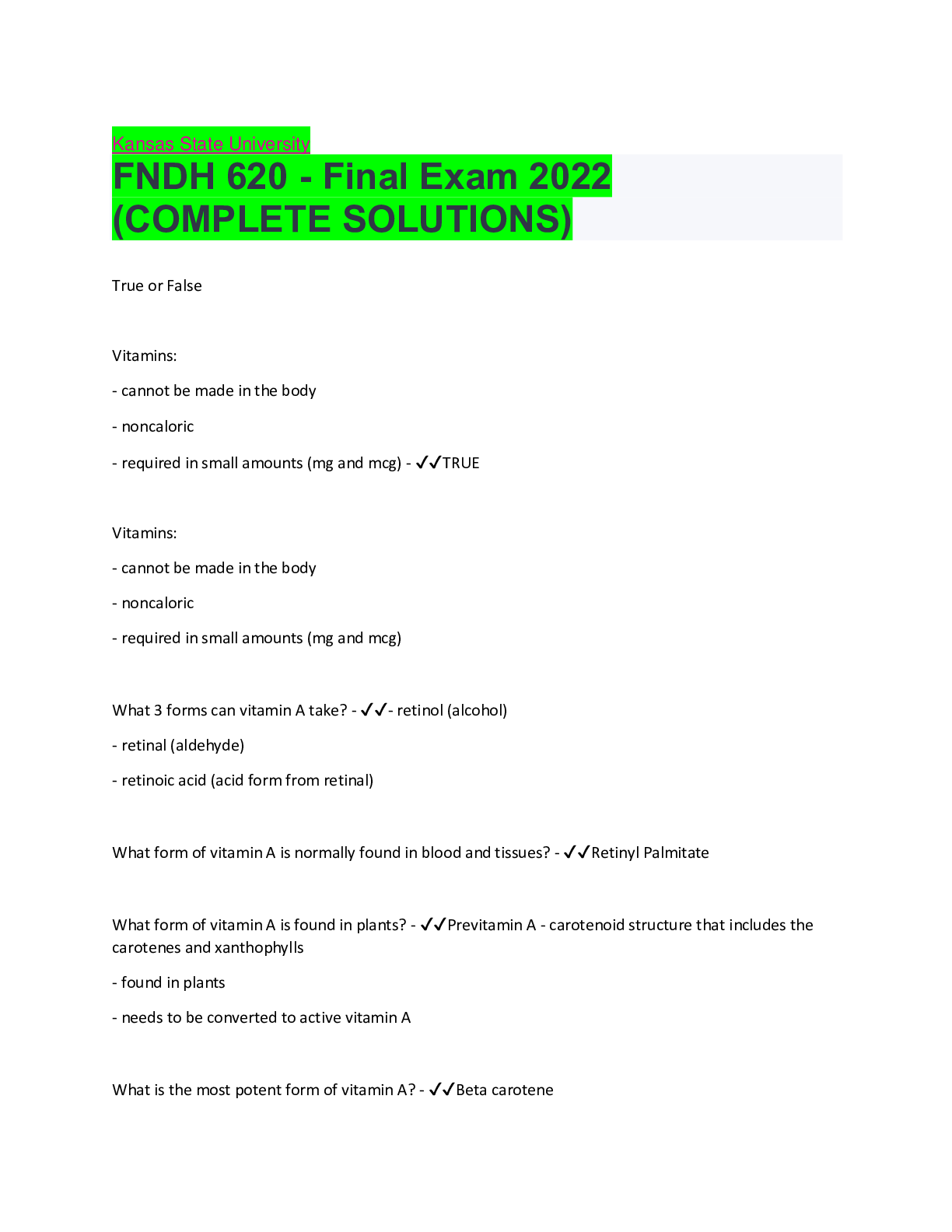
Buy this document to get the full access instantly
Instant Download Access after purchase
Add to cartInstant download
We Accept:

Reviews( 0 )
$6.00
Document information
Connected school, study & course
About the document
Uploaded On
Sep 04, 2022
Number of pages
46
Written in
Additional information
This document has been written for:
Uploaded
Sep 04, 2022
Downloads
0
Views
77


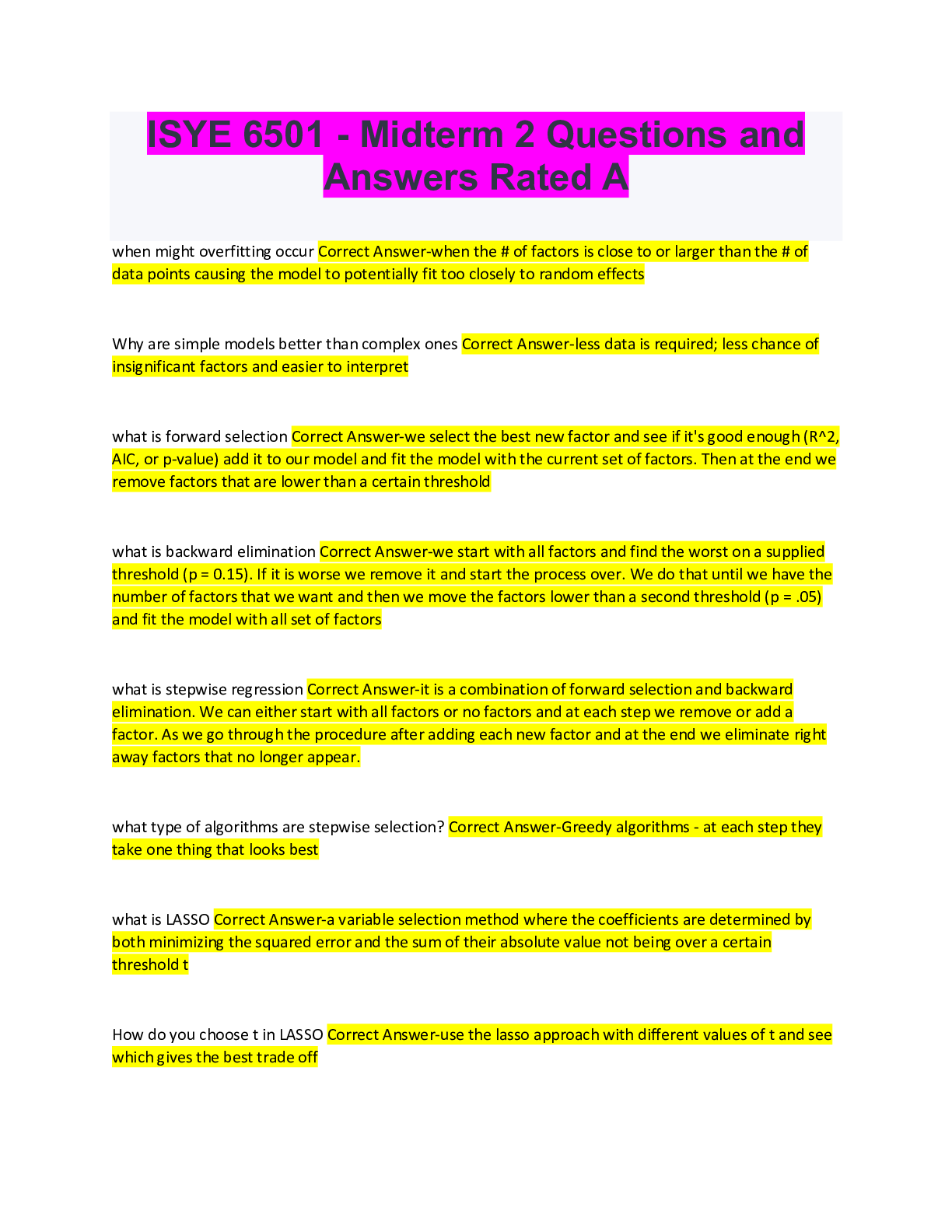









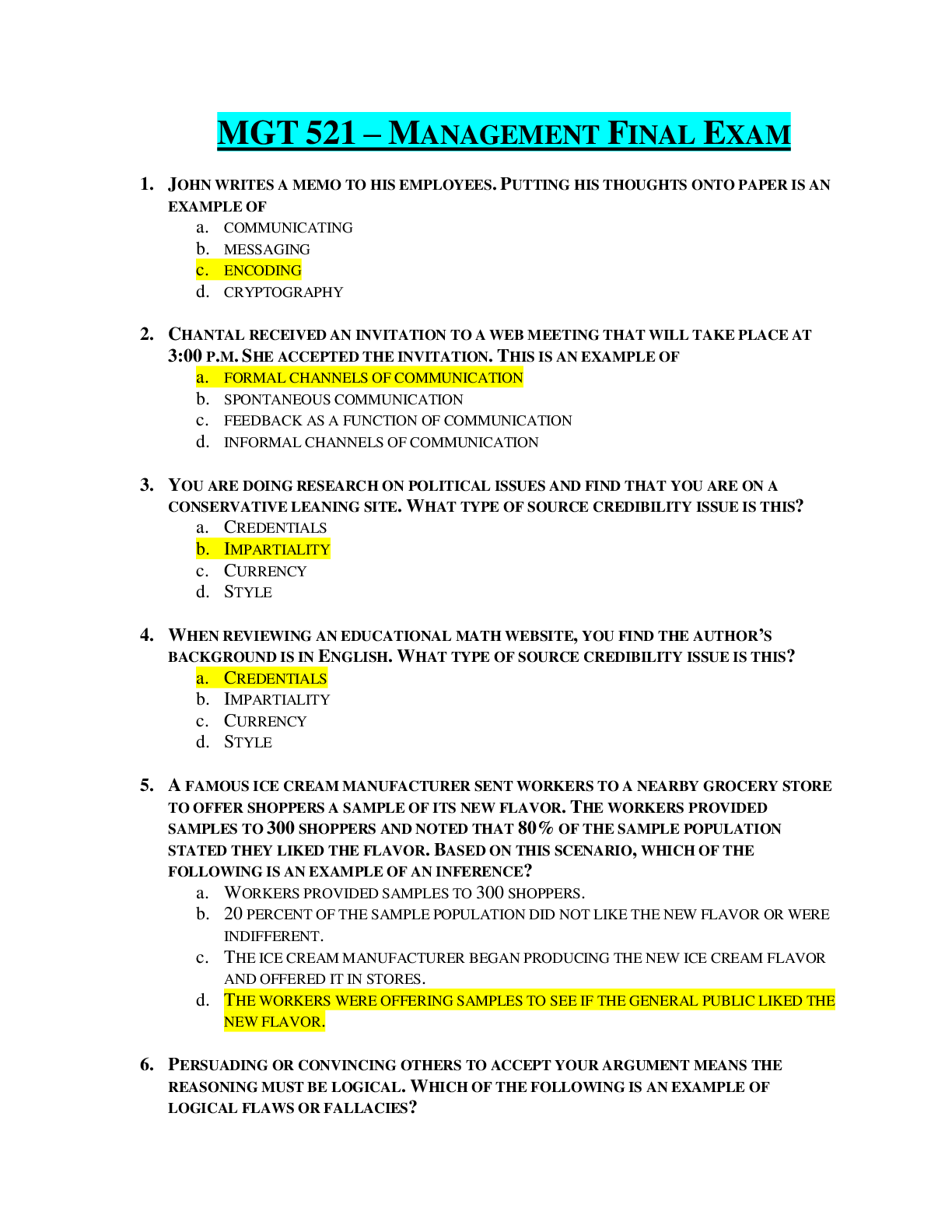



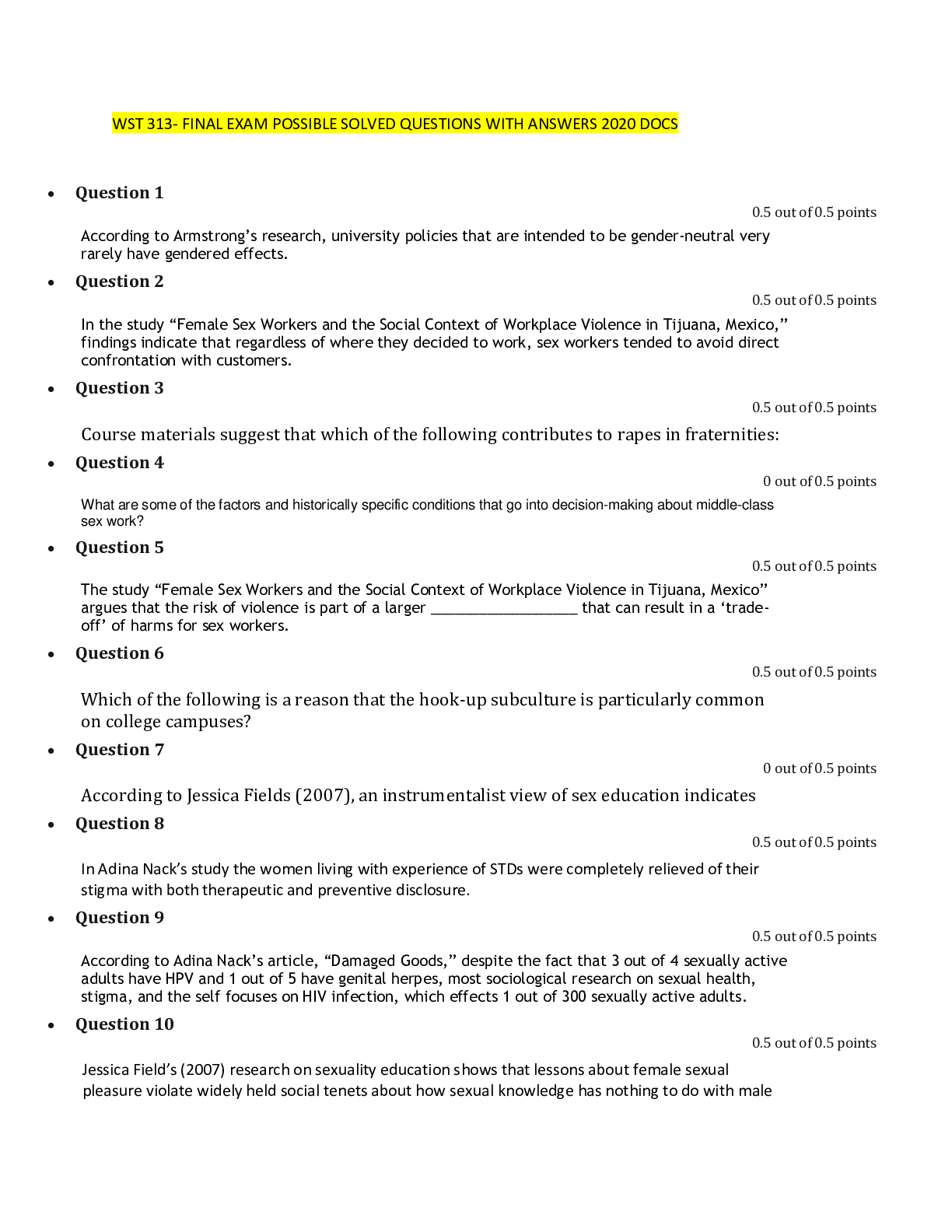

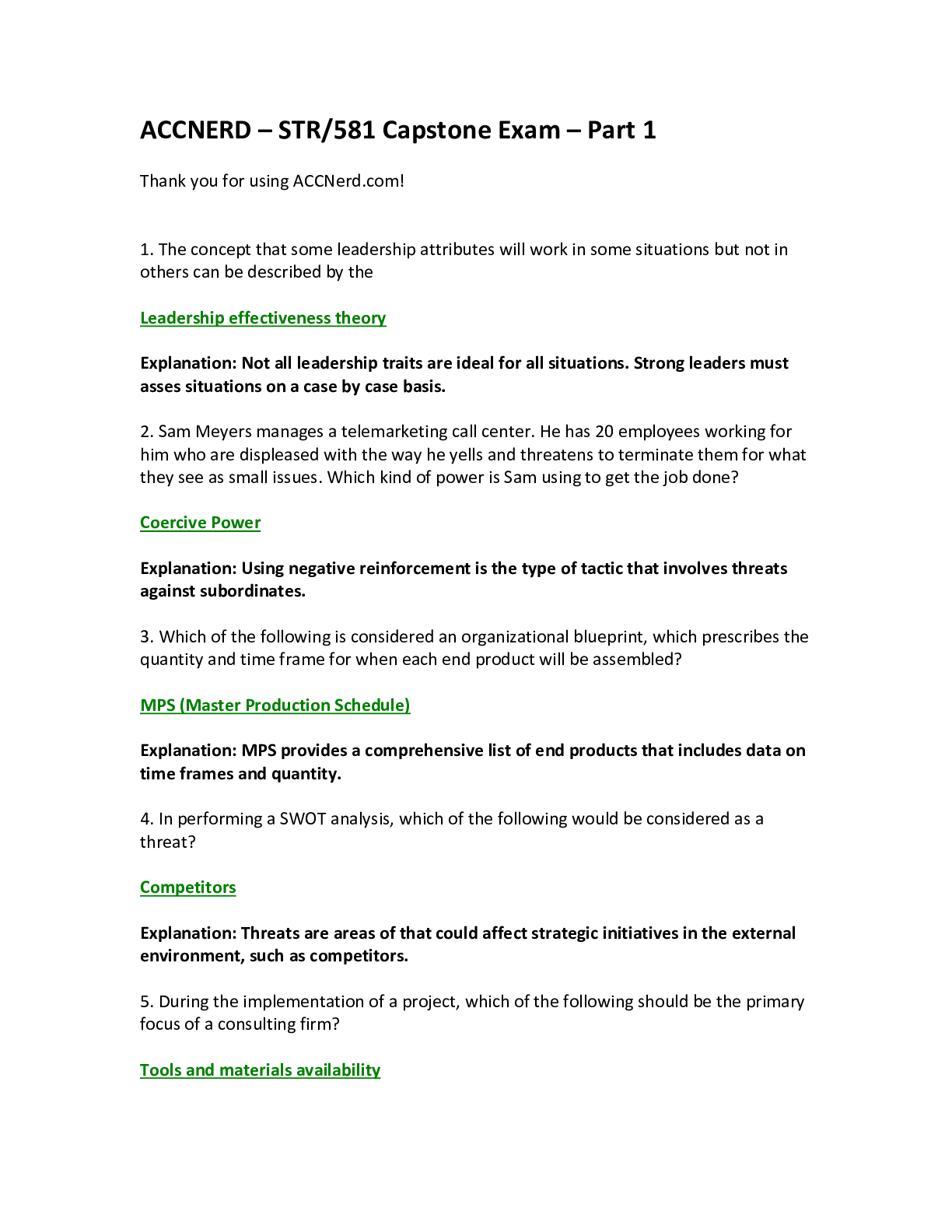

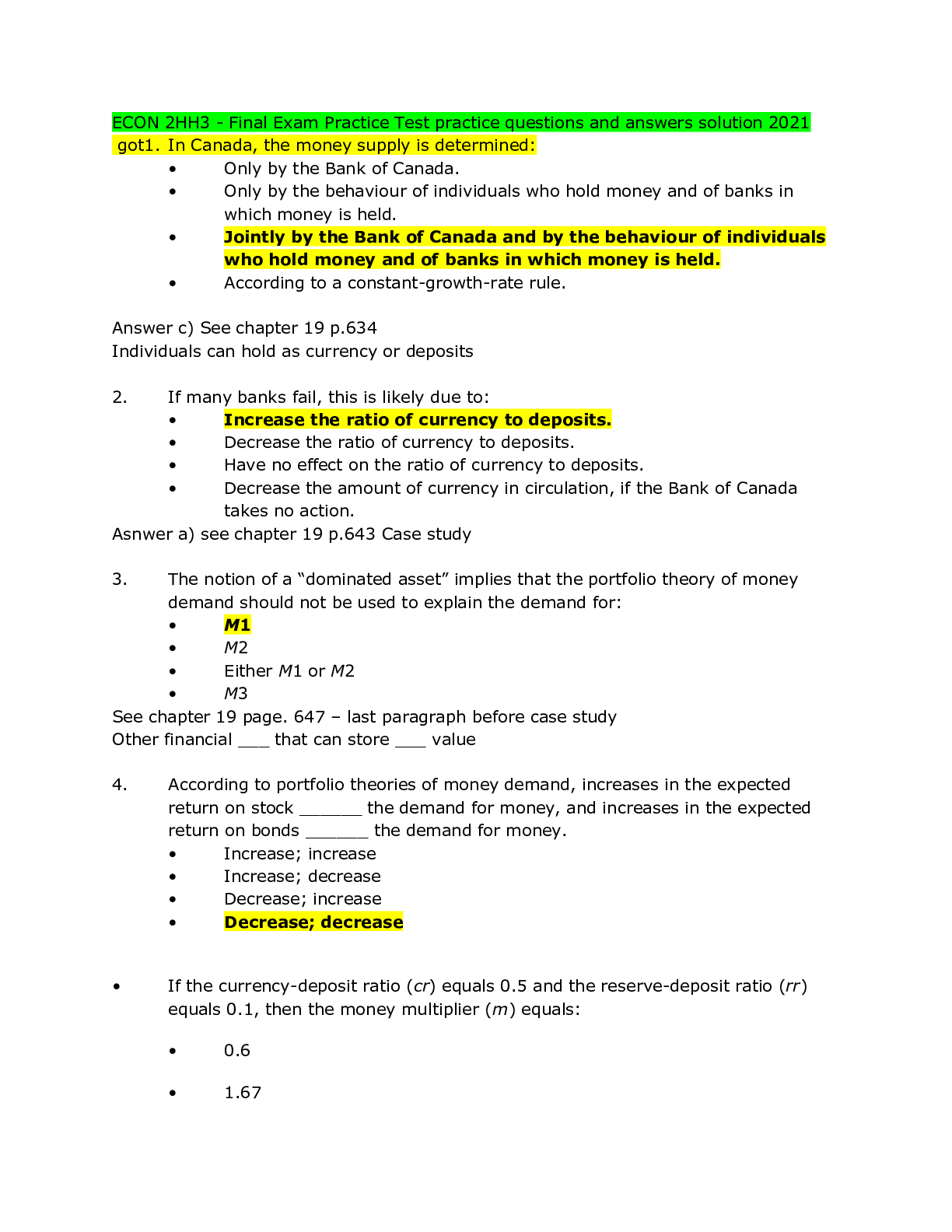

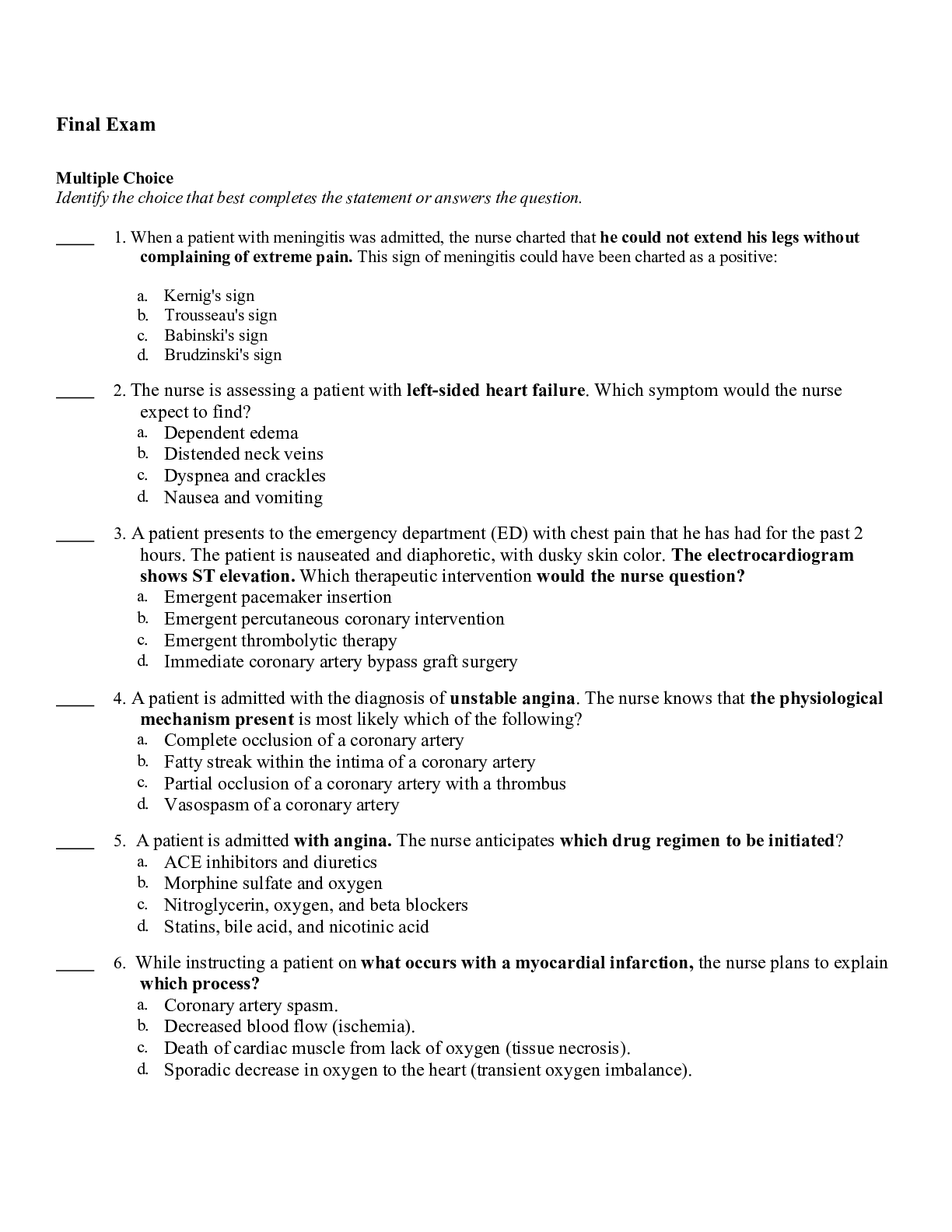
, All Correct, Download to Score A.png)

